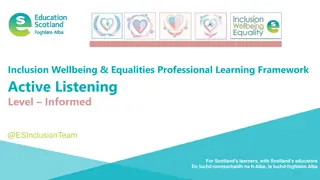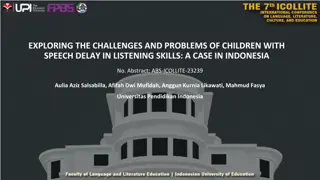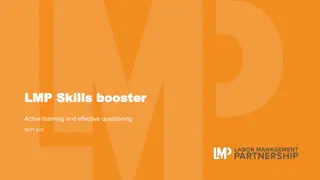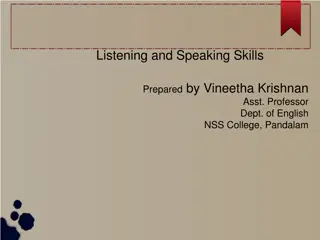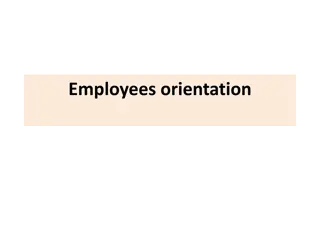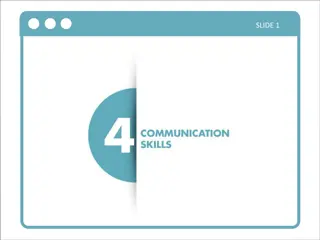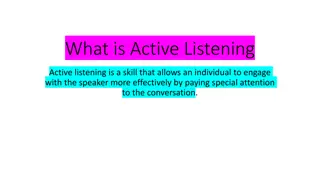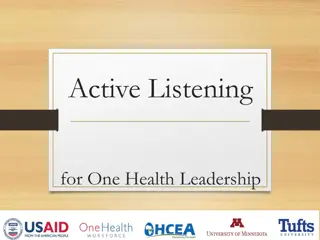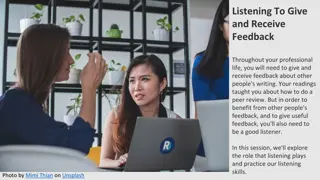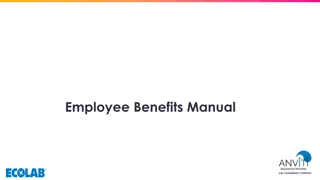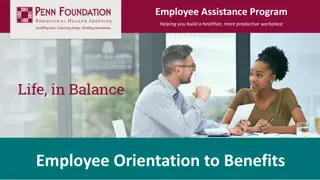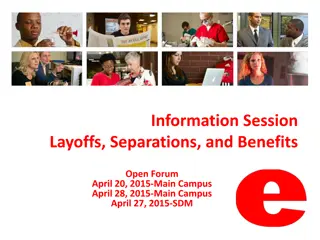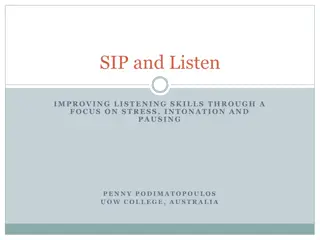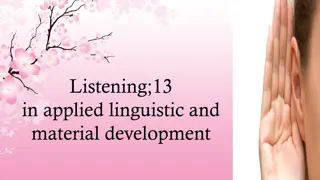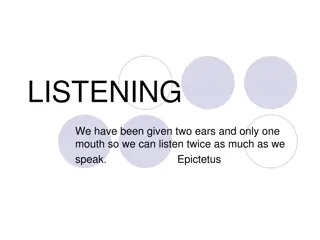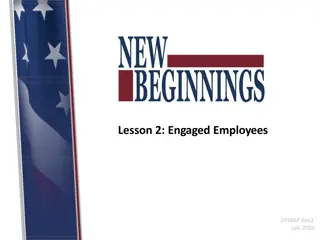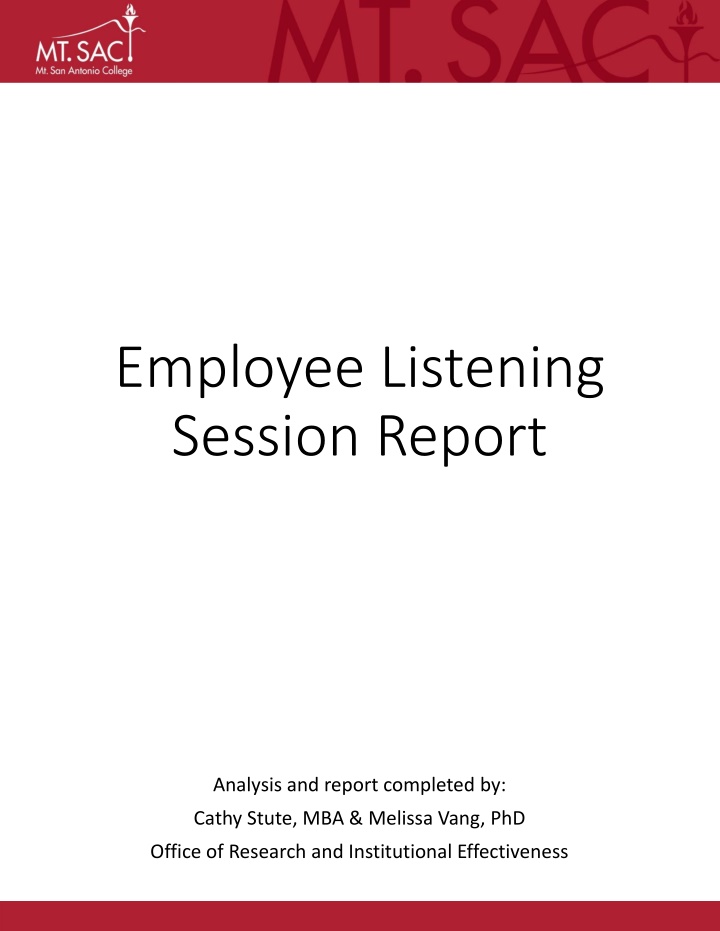
Employee Listening Session Report Analysis and Findings
Explore the comprehensive analysis and findings of the Employee Listening Session Report completed by Cathy Stute, MBA, and Melissa Vang, PhD, from the Office of Research and Institutional Effectiveness. The report covers completed sessions, participant demographics, Mt. SAC 2035 Guiding Framework, data collection, and analysis details. Gain insights into areas of opportunity and key observations from the sessions.
Download Presentation

Please find below an Image/Link to download the presentation.
The content on the website is provided AS IS for your information and personal use only. It may not be sold, licensed, or shared on other websites without obtaining consent from the author. If you encounter any issues during the download, it is possible that the publisher has removed the file from their server.
You are allowed to download the files provided on this website for personal or commercial use, subject to the condition that they are used lawfully. All files are the property of their respective owners.
The content on the website is provided AS IS for your information and personal use only. It may not be sold, licensed, or shared on other websites without obtaining consent from the author.
E N D
Presentation Transcript
Employee Listening Session Report Analysis and report completed by: Cathy Stute, MBA & Melissa Vang, PhD Office of Research and Institutional Effectiveness
Table of Contents Completed Sessions...................................................................3 Participant Demographic Overview............................................4 Mt. SAC 2035 Guiding Framework.............................................5 Data Collection and Analysis......................................................6 651 Classified Employees...........................................................7 262 Classified Employees.........................................................14 Faculty......................................................................................21 School of Continuing Education Faculty...................................29 Counselors................................................................................34 Conclusion Areas of Opportunity..........................................43 Appendix..................................................................................44 Appendix A 651 Classified Employee Demographics..........................................................................45 Appendix B 262 Classofied Employee Demographics...........47 Appendix C Faculty Demographics........................................49 Appendix D Crosswalk Classified Protocol.............................51 Appendix E Crosswalk Faculty Protocol.................................52
Completed Sessions 16 completed sessions By modality: 10 in-person sessions 6 virtual sessions via Zoom By classification: 2 651 classified professional sessions 5 262 classified professional sessions 3 general faculty sessions 2 part-time faculty sessions 1 counseling session 1 School of Continuing Education faculty session 2 general Mt SAC sessions
Participant Demographics Overview* 113 participants 68 classified professionals 40 faculty members 3 managers 1 professional expert *Please refer to Appendix A, B, & C for more information on participant demographics.
Mt SAC 2035 Guiding Framework Equity means Mt. SAC provides every student with an experience that gives them the conditions to develop their full academic and social potential. Equity-minded planning seeks to eliminate institutional policies, embedded practices, and systemic barriers that have enabled inequity to exist and persist at Mt. SAC. Healing-centered planning recognizes the assets of students from disproportionately impacted groups and prioritizes their success in institutional goal-setting and decision-making at Mt. SAC
Data Collection and Analysis Data Collection All employees were invited to participate in a Zoom or in-person listening sessions through email. All data collected over Zoom utilized the program's transcription function. All data collected for the in- person sessions was completed by scribing from the Office of Research and Institutional Effectiveness team. Data Analysis After the completion of compiling and cleaning the data, reseachers utilized the Mt. SAC 2035 framework centered on equity and healing. Data analysis was completed through thematic coding by group through Atlas.ti. In preparation of the report, the researchers developed a guide to frame the final analysis (see Appendix D & E).
651 Classified Employees
1. Contributions to Student Success 651 employees strive to maintain the College's buildings and vast grounds. They provide a clean, safe, aesthetically pleasing environment for students and employees to enjoy. Outside of their regular responsibilities they, too, connect with students to help them with directions, refer them to specific services and to provide support during challenging times. "If we create a clean environment it allows the professors to do their job without being distracted. It creates a really good environment for students to learn and to be successful..." "A student was paying his parking permit, and had a seizure and the students who were around tried to help the student...I stepped in, called the paramedics, and I talked him through it, told him he was going to be okay. We help all the time, we wait with students if they are having car trouble for someone to come and help." 651 Classified Employee 8
2. What is working well? 651 employees expressed that Mt. SAC offers many resources; and the college meets the needs of the diverse student body by offering online and non- traditional courses. They also identified the new facilities as beneficial for students. "The resources and definitely I hope people have gone through the bridge program, I don't know if we still have that, but that was helpful for my family." "In the summertime you see the high school students and the kids. It s a good thing because it puts in their mind that they can go to college." "The new building (410) is amazing for the students" 651 Classified Employee 9
3. Challenges - Students 651 employees identified safety as the biggest challenge for students at Mt. SAC followed by challenges with building identification and wayfinding. "I think for me the biggest issue that every college is going to have is an active shooter...." "The uber situation is really bad. Either they are driving on campus or just stop..." "Signs. Building signs are too small." "...we re the first people they see and for those who are lost..." 651 Classified Employee 10
3. Challenges - Employees Challenge specific to 651 employees include maintaining cleanliness and the lack of staffing to maintain the College. "We have trash cans out but please throw stuff away. People leave their trash on top of the trashcan and when we get there the trashcan is empty, but the trash is on top of it. People leave trash outside of the trashcans." "They can help us a lot if they push in the chairs at the end of class. If there are 40 chairs to push in then its time consuming. Something so simple helps us." "We have about 25 employees: 1 plumber for an entire community." 651 Classified Employee 11
4. Campus Needs - Students In response to questions regarding needs and spaces for students, 651 employees commented that wayfinding and additional new facilities to house resources, gathering spaces, and technology would benefit students. "The building numbers! I ve been here for 20 years, and they keep saying we re working on it." "I would say 410 is a perfect example you have very accessible and all the options for students" 651 Classified Employee 12
4. Campus Needs Employees Staff from 651 expressed critical needs to support them in their work in these these areas: facilities, equipment/supplies, staffing, and acknowledgement from the campus. "There should be an employee center. There is no space on campus...We should have a space where we can eat and take a breath." "[W]e were supposed to get lockers for the custodians to put their gear in, and they said they took them out of gym three and they were going to install them for us. It didn't happen and they said they didn't know what happened to the lockers." "More employees, look at how big this campus is." "{A}s custodians we do get that a lot who are you? why are you in here? 651 Classified Employee 13
262 Classified Employees
1. Contributions to Student Success Across the listening sessions, 262 employees demonstrated how they extended services beyond their roles to support students. While many student-facing staff described their engagement with students were often to address student's concerns, provide direction on campus, and respond to student's emails and calls, staff who did not work directly with students shared how they supported students in different capacities. "I don't get a lot of face time with students, but I just try to wear my name tag and let people know I work there. So, if they have questions, they know they can approach me. And sometimes if I see someone standing in front of a sign or if they look lost, I ask them if they need any help." "I'm behind the scenes. I don't have a lot of student interaction. However, I do try to volunteer at events and things that are happening on campus." 262 Classified Employee 15
2. What is working well? A reoccurring response to what was working well at Mt. SAC was the high number of services and programs provided to students. Services such as the robust academic support such as the Writing Center, STEM Center, ASAC, free bus voucher, and Basic Needs. "I think it's working well that we have no shortage of support services. There are so many different offices that students can use to get services." "If there's anything I'd have to agree that we have a lot of support services for our students, more than a lot of other colleges around the area. I think we have all these centers and all these places they can go and interact with each other, and we just have the brand-new student center. So yeah, we have a lot of good things on campus for our students to interact." 262 Classified Employee 16
3. Challenges - Students 262 Staff mentioned students' challenges with the enrollment and registration processes and the need for additional support for underrepresented student groups and identities such as LGBTQ+ and neurodivergent students at Mt. SAC. "We have an employee struggling to get through the process. If it s a student, we're making it too hard for students. They'll just leave...We're losing them before they even can register" "Limited resources tailored for the LGBTQ+ community, such as mental health support and specialists in gender affirming healthcare. There are students who come to us hoping to receive such care that they have trouble getting by themselves, but we can only make them aware of outside resources." "Adults with disability is removed from campus. Neurodivergent students also need a space on campus." "I feel like the college could do better in providing resources to a diverse group of students. More specifically, for those receiving ACCESS and DHH services." 262 Classified Employee 17
3. Challenges - Employees Staff shared challenges that were negatively impacting their experience and workload at the college. Data analysis revealed that the work culture, current and new processes, and lack of engagement among employees were challenges identified. "Easy on the on the red tape on restricting us on our processes. I don't know about other divisions, but for our division, we have a lot of red tape being placed on how things need to be done whether it's paperwork, workflow, and it's getting just really confusing. It's taking a lot more time to just even do a transfer to your P card allocation. It's just a lot of jumping hurdles now." "I'm new and there's a lot of systems and things that I don't have access to that I'm finding out that I need access to. There's still a lot of like policies and procedures...Just like little things like that. There are so many different procedures and things that are done a specific way at Mt. SAC in order to get stuff done in a timely manner." 262 Classified Employee 18
4. Campus Needs - Students Staff shared the need to improve college communication to students and how to ensure students are well prepared to transition to the college and have appropriate information to support their academic journey during their time at Mt. SAC. "I also think that we need to do a better job as an institution when it comes to updates sending that out immediately, not delaying. I don't know if students are aware of the renumbering that's happening on campus. I feel like if we do communicate it's like a one and done. There's no like reminders or it's just not repetitive" "In general, I think we could improve as far as like communication goes with our students. on how we reach out and tell them what's needed, what you know what they can do to smooth the process as well, because a lot of the hiccups come with students maybe not necessarily understanding what they need to turn into us. So, I think that could help is just communication emails to students." 262 Classified Employee 19
4. Campus Needs Employees Staff addressed the need of more training on various aspects of the college from onboarding and throughout the staff's employment at the college about the campus, technology applications, and diversity, equity, and inclusion (DEI). In addition, staff mentioned the importance of employee engagement to develop relationships across the college in order to foster a welcoming environment for students. "Better training to be able to utilize technological innovations or software or other things like AI. As somebody that's struggling with teaching other people to use Chrome having a link with YouTube's is really just not helpful. So just I would say more interpersonal types of training to be able to utilize these technological innovations in a more productive and efficient fashion" 262 Classified Employee 20
Faculty Full-time & Part-time
1. Contributions to Student Success Faculty mentioned nuanced strategies to build rapport with students and foster a humanizing learning environment. Many faculty members distributed a pre- surveys prior to the start of the course to get to know students better, shared their own personal background and challenges navigating through their educational journey to co-create the learning space with students. I do similar things I have students tell me about themselves in a lot of different ways and ask how I can support them. And I specifically ask if they have anything that they think I should know about I always do my own survey at the beginning of the semester where I ask about their background and identities, if they have access to computers at home or not, or if they have family obligations whether they have their own children or family members that require their support to take them to a regular doctor's appointments or this or that. Faculty 22
2. What is working well? Across all listening sessions Faculty highlighted the College's robust academic programs and student services that are available for students. Students have more information about transfers and how to transfer to their schools They're kind of across the campus in a number of ways, but students across the campus are well supported by the Writing Center. I know students who do use the Writing Center have had a positive experience and are benefiting from the tutors that they send to other places on campus as well. Faculty 23
3. Challenges - Students From their engagement with students, faculty expressed the critical need of students basic needs. Basic needs were specific to mental health, housing, and childcare. A few faculty also addressed challenges LGTBQ+ students and deaf and hard-of-hearing students were experiecing on campus. We are having so much more mental health crises this semester than we had last semester...So that's a massive barrier and I know that it impacts all of our students, not just our LGBTQ+ students. Mental health is a massive issue for our students so many students are not getting reached by structures that we're trying to set up to help them even though we might supposedly have systems for mental health. "One student came to me and asked how to request for interpreters. The student ended up getting interpreters that they were not comfortable with and did not want to use them. But the student did not have a choice." Faculty 24
3. Challenges - Employees Faculty discussed various challenges that impacted their role such as workload and outdated equipment and technology. Faculty also discussed the lack of faculty diversity, part-time faculty, and lack of support for deaf and hard-of-hearing faculty. "Faculty teach 15 LHE which translates into five classes plus their office hours, plus all the grading, et cetera, et cetera. So where do we build in time for faculty to engage?." "Outdated or insufficient technology and equipment. It is making it harder to compete in professional environments post-graduation." "I'm a hearing person and not a deaf person, but we're having major issues with the HR on campus. Specific to providing equity and communication by providing interpreters which shouldn't even be a thing," Faculty 25
4. Campus Needs - Faculty Faculty expressed their dedication of providing students with an excellence classroom experience. However, faculty also expressed the need for administrative support so they can focus more on students. Faculty shared that the need for administrative support would help their workflow and allow them to focus on students. Administrative support for the tasks that you need to do. All of the other extra little things that we have to do as faculty to make sure that we're meeting certain needs and closing those gaps, but it's very time consuming. If we can have some assistance with clerical duties that would be very helpful. It takes up time from meeting with students, really getting to support them with tutoring. Faculty 26
4. Campus Needs - Spatial Needs Faculty described the need for space that is accessible with clear signage and displays of diverse cultural representations. More importantly, faculty expressed the need for communal space to build community, hold office hours, and engage with students. Lots of pictures/artwork reflecting the diversity of the campus. Music from different cultures and backgrounds. Hanging the Pride flag alongside the US flag. Staff/faculty from diverse backgrounds to be in that space. Space for community events/movie screenings/potlucks. Signage in multiple languages with printed material in multiple languages with pictures of actual Mt. SAC students (no stock photos). Free coffee/tea/water. Spaces to build community. Faculty 27
4. Campus Needs - Technology Needs Technology needs that emerged from the data focused on providing updated technology and software programs in the classrooms and stronger wireless fidelity (Wi-Fi) on campus. Please upgrade the desktop computers in classrooms - some are very outdated and include technology for hybrid meetings/events. We do not have a program like Kahoots as a support for faculty - buy the license so we can use Kahoots or a similar program. Updating the technology we currently have. In the classroom and the Wi-Fi access. The Wi-Fi is spotty. We still have the docu cams with the projector. It would be nice to have it updated if we're talking about the future. "Additional technological needs included improving the heating and cooling systems in buildings to maintain a comfortable temperature for students and faculty." Faculty 28
School of Continuing Education (SCE) Faculty
1. Contributions to Student Success School of Continuing Education (SCE) faculty report that they serve a very diverse population. They strive to offer excellent customer service to all who attend the various programs. "[The] student population is very diverse. Students have different needs" "Faculty cares for their students, the difference between SCE and Credit is customer service, SCE shines, they go the extra mile for the student s needs" School of Continuing Faculty 30
2. What is working well? In response to the question of what is working well, SCE faculty identified certain systems or processes that enhanced the student experience as well as the many student-focused programs offered. "Another thing built into noncredit which removes barriers, open entry/exit." "They have mirrored courses. They are taking a seat in a credit class as a non credit student without worrying about their grade, but can be converted into a credit, the student has the opportunity to repeatedly take the class" School of Continuing Faculty 31
3. Challenges SCE faculty identified a challenge with Mt. SAC's DEISA efforts. In addition, specific facilities challenges such as being housed in temporary buildings, lack of space and no water, were frequently discussed by SCE faculty. Also, safety issues involving infestations and excess room occupancy affecting both students and staff were mentioned. "Accessibility is lacking in DEISA" "At times water is not available, they were told that they would have a better space with running water. No water is available now." "Safety is a concern, building 30 has snakes" "Classes are overlimit to the point of fire hazard" School of Continuing Faculty 32
4. Campus Needs SCE faculty offered recommendations on how to better serve students including permanent facilities, on-campus transportation and seating areas for students to eat or complete schoolwork. "Every building has been rebuilt or remodeled, except building 30" "Microwave in the hallway for students, students have nowhere to place their food, students sit and eat along the hallway floor, compared to the Equity Center, they have a place for students. We don't have a place for students to sit." School of Continuing Faculty 33
1. Contributions to Student Success Counselors contribute to student success through a variety of interactions with students. They provide guidance one-on-one or through various programs, workshops and events. Constantly engaging with our diverse student body, they understand that diversity is critical to serving our students. "For me it is breaking power dynamic with students." "We do a monthly connect series with students, where we physically have an engagement. We also have our parenting circles; we do that bimonthly. This is an ongoing activity." "It [diversity] is extremely important" Counselors 35
2. What is working well? Counselors highlighted key aspects the student experience: the numerous student supports and services offered, and the multitude of courses and programs supported by dedicated faculty in instructional programming. "Our student services I believe they are amazing. There is so much to choose from." "They feel the professors are really good." "Students have reported that faculty really care about them" Counselors 36
3. Challenges - Students When asked about challenges our students face, Counselors raised concerns that the College is not yet student centered; that non-traditional students are not receiving the support they need. They expressed concerns about the impact of not receiving support. "We don't meet students where they are at. The college says that yes we want you here, but they forget about providing services." "So, they (students) feel frustrated. and they feel dismissed that we don't care about them" Counselors 37
3. Challenges - Counselors Challenges Counselors experienced include missed opportunities for collaboration or communication , cumbersome systems or processes, and increasing burnout among their peers. "Collaboration. More meetings to define roles and expectations. A & R what is your role? Evaluator's role? What is the counselor's role?" "I think of promise plus and a student was only able to enroll in 5 units because of her disabilities and yet this may impact her eligibility for Promise Plus." "I see 13 to 14 students a day. Write case notes for each one. Burnout. Employee center is available but when do we have time to go there or attend events?" Counselors 38
3. Challenges - Campus Counselors identified diversity as a major campus- wide challenge. Concerns were voiced that diversity is not prioritized and it is inconsistent across departments and programs. "We can do a better job. Especially for students who don't necessarily belong. Actions speak louder than words. I think a lot of people walk the walk but don't talk the talk. We can make this more of a priority." (Heard from other employees) "My job is to teach [subject] and that's all." Counselors 39
4. Campus Needs - Student When asked how to support the needs of students, Counselors touched on new facilities spaces to provide for students' specific needs. They also referred to additional supports and services not currently offered at Mt. SAC. "We do hear it often that students can't access the second floor." "We do have a parenting scholar but it's not a recognized defined program. There is a big need. Students need services. [They don't] quality for EOPS, CalWORKs or Next Up." Counselors 40
4. Campus Needs - Counselors Counselors expressed needs for support in three areas: improved systems and processes, better communications and opportunities to engage in collaboration, and staffing resources to alleviate the burnout they are experiencing. (Referring to appointment scheduling) "We don't have privilege to talk tomorrow. 2 weeks in advance." "We don't know when our first day of registration is going to be. We don't get the proper information to do the simplest things. Give us the tools and give us the information. We don't get information to the students. If we don't know it, the student doesn't know it." "We are advocating for processes that don't burn us out" Counselors 41
4. Campus Needs - Technology Counselors discussed technology as a solution to improve service across campus. Technology needs include new hardware to support counselors, and applications to improve information flow. "My laptop decided to turn off. It took me 10 minutes to get it going on." "We should integrate technology that will get students connected with different programs. One example, is that a counselor can complete a form so that when they talk to financial aid (for example), financial aid will know exactly what the student will need." Counselors 42
Conclusion Areas of Opportunity Data from the employee listening sessions provided valuable insights into how employees are currently contributing to student success, what is working well, challenges from their vantage point, and what needs would support their role. Some commonalities across the listening sessions was the employee's dedication to the College's mission of serving students and providing a welcoming environment along with the numerous resources that are offered. As the College continues to work towards Mt. SAC 2035 some areas of opportunity to consider for employees: Improve processes and practices to support deaf and hard-of-hearing faculty and staff Provide ongoing engagement opportunities for employees to build relationships and understand the various programs offered to students Diversify faculty representation across the college to reflect the student population Demonstrate how employees contribute to student success as an onboarding practice Acknowledge employees for their dedication the College and contributions to student success Foster a culture of care, trust, and support for employees to thrive Utilize the College's Restorative Justice program to support in healing and community building
Appendix A 651 Classified Employee Demographics Number of years at Mt. SAC 1-5 years 6 6-10 years 1 11-15 years 2 16-20 years 1 20 years or more 4 Race/Ethnicity Asian 1 Black/African American 7 Latine/x/Hispanic 4 Native American 2 Pacific Islander 1 White 4 Other 1 Unreported 4 Gender Identity Woman 4 Man 11
651 Classified Employee Demographics Age 25-29 years old 1 30-34 years old 0 35-30 years old 0 40-49 years old 5 50 years old or older 5 Did not share 3 Sexual Identity Straight 11 Did not share 3
Appendix B 262 Classified Employee Demographics Number of years at Mt. SAC 1-5 years 22 6-10 years 13 11-15 years 9 16-20 years 8 20 years or more 7 Race/Ethnicity Asian 10 Black/African American 7 Latine/x/Hispanic 29 Native American 2 White 14 Other 2 Unreported 2 Gender Identity Non-binary 2 Woman 46 Man 7 Did not share 2
262 Classified Employee Demographics Age 25-29 years old 7 30-34 years old 7 35-30 years old 3 40-49 years old 24 50 years old or older 14 Did not share 2 Sexual Identity Asexual 2 Bisexual 5 Gay 2 Queer 2 Straight 42 Other 1 Did not share 5
Appendix C Faculty Demographics Number of years at Mt. SAC 1-5 years 4 6-10 years 19 11-15 years 4 16-20 years 8 20 years or more 13 Race/Ethnicity Asian 11 Black/African American 2 Latine/x/Hispanic 18 White 26 Gender Identity Queer 1 Woman 38 Man 7 Did not share 1
Faculty Demographics Age 25-29 years old 7 30-34 years old 7 35-30 years old 3 40-49 years old 24 50 years old or older 14 Did not share 2 Sexual Identity Bisexual 1 Gay 2 Lesbian 1 Queer 5 Straight 36 Other 1 Did not share 3

